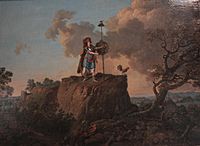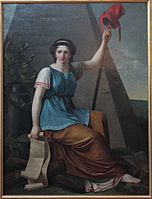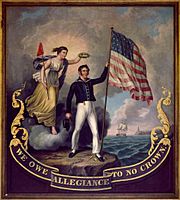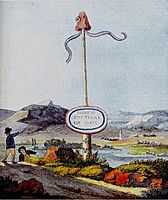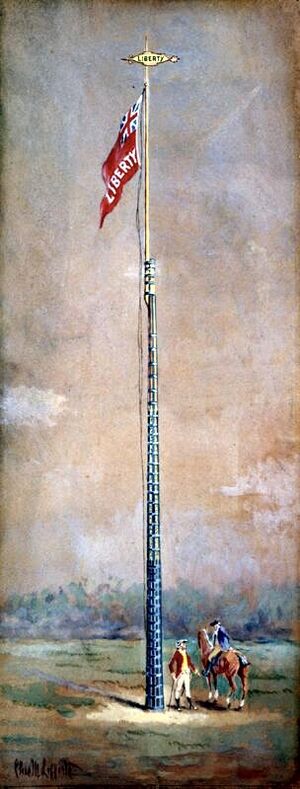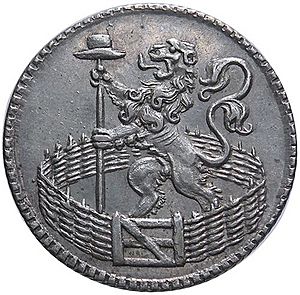Liberty pole facts for kids
A liberty pole is a tall wooden pole. It often has a special "cap of liberty" on top. This cap is usually a Phrygian cap, which looks like a soft, cone-shaped hat. The idea of the liberty pole started a very long time ago in ancient Rome.
Around 44 BCE, after the Roman leader Julius Caesar was killed, some people who called themselves "Liberators" walked through the streets. They carried a special hat called a pileus on a spear. This pileus hat was worn by slaves who had just been set free. Carrying it on a spear showed that the Roman people were now free from Caesar's rule, which the Liberators thought was like a tyranny.
Later, the Roman goddess of liberty, Libertas, was often shown holding a pileus hat and a pole. Both of these items were part of the ceremony to free a slave. Even though the pileus was different from the Phrygian cap, over time, people started to confuse them. This led to the Phrygian cap becoming the main symbol used on liberty poles.
After the Renaissance (a period of rebirth in Europe), the liberty pole became a common symbol of freedom. At first, it was a small symbol carried by figures representing liberty. Later, it became a large, real pole planted in the ground, like a flagpole.
Contents
Freedom Symbols Through History
When the idea of the liberty pole came back in the 1500s, it was often shown with figures that represented nations or political ideas. For example, in Italy, the city of Venice had a painting where a woman representing Venice was next to a figure of Liberty. This Liberty figure was holding a red Phrygian cap on a spear.
The Dutch Maiden, who was the symbol of the Dutch Republic fighting for freedom from Spain, often held a hat on a pole. This hat was a regular man's hat from that time. Even in Britain, the symbol was used. When Britannia, the symbol of Britain, was shown as "British Liberty," she would hold a liberty pole instead of her usual trident. A huge monument called the "Column to Liberty" was built in England in the 1750s. It has a bronze woman on top holding a cap of liberty on a pole.
During the 1700s, the ancient Roman pileus hat was often mixed up with the Phrygian cap. Because of this mistake, the Phrygian cap became the standard shape for the "cap of liberty" in political symbols.
- Liberty poles carried by symbols of freedom
-
The seal of Napoleon Bonaparte's government, 1799.
-
A statue of the Dutch Maiden in Rotterdam, 1874.
-
A liberty pole marking the French border in 1793, drawn by Johann Wolfgang von Goethe. It says "This land is free."
American Revolution and Liberty Poles
Liberty poles were often put up in town squares before and during the American Revolution. Places like New York City, Concord, Massachusetts, and Savannah, Georgia had them. These poles were a way for colonists to show their disagreement with British rule.
In New York City, there was a long and sometimes violent fight over liberty poles. The Sons of Liberty, a group of American patriots, would put up poles. The British authorities would then tear them down. But the Sons of Liberty would always put up new ones. This conflict lasted for about 10 years, from 1766 until the American Revolution began in 1775. The New York City liberty pole had a golden flag on top with the word "Liberty."
Sometimes, instead of a pole, a "liberty tree" was used for the same purpose, especially in Boston.
During the Siege of Boston in 1775, a very tall liberty pole was put up on Prospect Hill. This pole was made from a ship's mast that had been captured from a British ship. When a red flag was raised on a liberty pole, it was a signal for the Sons of Liberty or townspeople to gather. They would meet to talk about their feelings and protests against British rule. The pole was a strong symbol of standing up against Great Britain.
Other Uses of the Symbol
During the Whiskey Rebellion in western Pennsylvania, people put up poles to protest a new tax on alcohol. They did this to remember the spirit of the liberty poles from earlier times.
The "liberty trees" (arbres de la liberté) were a symbol of the French Revolution. These were usually real, living trees that were newly planted. The first one was planted in 1790. A liberty tree was also planted in Amsterdam in 1795 to celebrate an alliance with the French Republic.
The image of Liberty holding a pole with a Phrygian cap can also be seen on the coat of arms of Argentina. It also appears on many US silver coins from the mid-to-late 1800s. These coins are known as United States Seated Liberty coinage.
Places
- Liberty Pole, Wisconsin, a small community in the United States.
See also
 In Spanish: Poste de la libertad para niños
In Spanish: Poste de la libertad para niños




